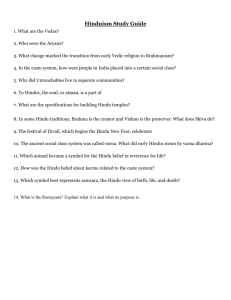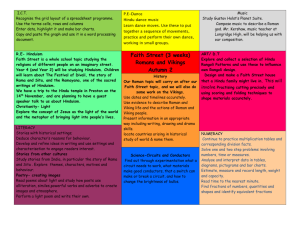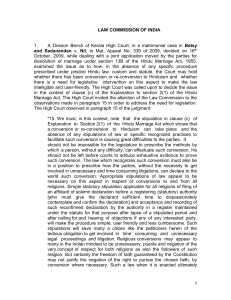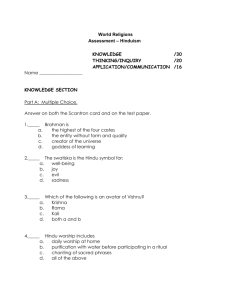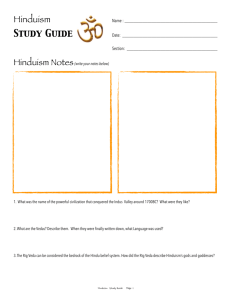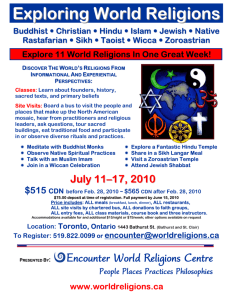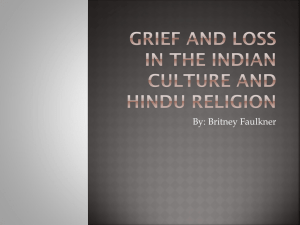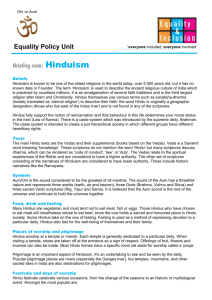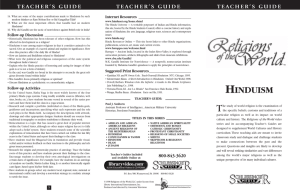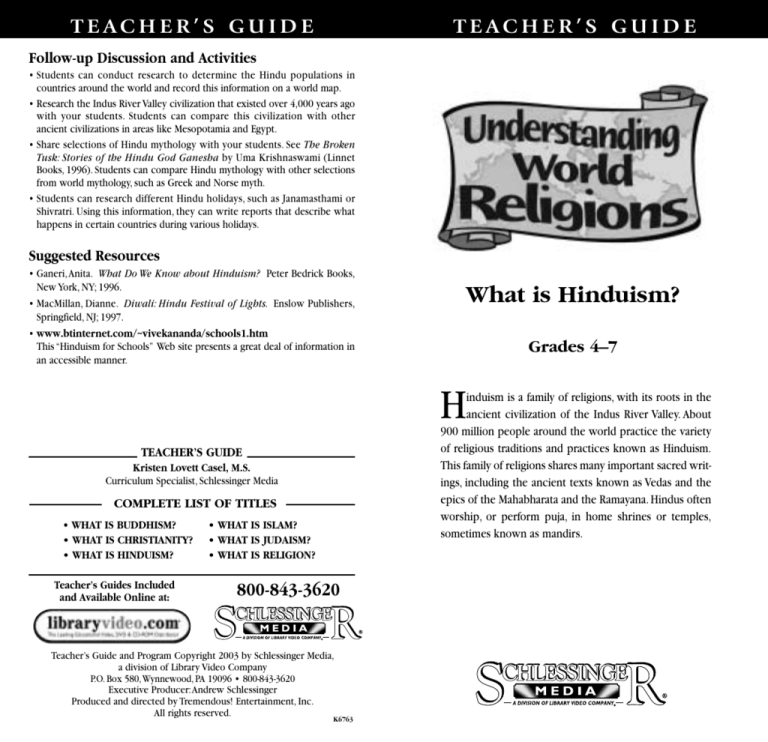
TEACHER’S GUIDE
TEACHER’S GUIDE
Follow-up Discussion and Activities
• Students can conduct research to determine the Hindu populations in
countries around the world and record this information on a world map.
• Research the Indus River Valley civilization that existed over 4,000 years ago
with your students. Students can compare this civilization with other
ancient civilizations in areas like Mesopotamia and Egypt.
• Share selections of Hindu mythology with your students. See The Broken
Tusk: Stories of the Hindu God Ganesha by Uma Krishnaswami (Linnet
Books, 1996). Students can compare Hindu mythology with other selections
from world mythology, such as Greek and Norse myth.
• Students can research different Hindu holidays, such as Janamasthami or
Shivratri. Using this information, they can write reports that describe what
happens in certain countries during various holidays.
Suggested Resources
• Ganeri,Anita. What Do We Know about Hinduism? Peter Bedrick Books,
New York, NY; 1996.
• MacMillan, Dianne. Diwali: Hindu Festival of Lights. Enslow Publishers,
Springfield, NJ; 1997.
• www.btinternet.com/~vivekananda/schools1.htm
This “Hinduism for Schools” Web site presents a great deal of information in
an accessible manner.
What is Hinduism?
Grades 4–7
H
induism is a family of religions, with its roots in the
ancient civilization of the Indus River Valley. About
900 million people around the world practice the variety
of religious traditions and practices known as Hinduism.
This family of religions shares many important sacred writings, including the ancient texts known as Vedas and the
epics of the Mahabharata and the Ramayana. Hindus often
worship, or perform puja, in home shrines or temples,
sometimes known as mandirs.
TEACHER’S GUIDE
Kristen Lovett Casel, M.S.
Curriculum Specialist, Schlessinger Media
COMPLETE LIST OF TITLES
• WHAT IS BUDDHISM?
• WHAT IS CHRISTIANITY?
• WHAT IS HINDUISM?
Teacher’s Guides Included
and Available Online at:
• WHAT IS ISLAM?
• WHAT IS JUDAISM?
• WHAT IS RELIGION?
800-843-3620
Teacher’s Guide and Program Copyright 2003 by Schlessinger Media,
a division of Library Video Company
P.O. Box 580,Wynnewood, PA 19096 • 800-843-3620
Executive Producer:Andrew Schlessinger
Produced and directed by Tremendous! Entertainment, Inc.
All rights reserved.
K6763
Guidelines for Teaching about
Religion in Public Schools
Dr. Charles C. Haynes
Senior Scholar and Director of Education Programs
First Amendment Center,Arlington,Virginia
Educators widely agree that religion plays a significant role in history and
society. Failure to understand the basic symbols, practices and concepts of the
major world religions makes much of history, literature, art and contemporary
life unintelligible. Clearly, study about religion in public schools is an important
part of a well-rounded education.
At the heart of this agreement about the importance of teaching about religion
are three major principles:
1. The Supreme Court has repeatedly made it clear that study about religion
(as distinguished from religious indoctrination) in public schools is constitutional.
2. The study of religion is tremendously important if students are to be educated about history and culture.
3. Public schools must teach about religion objectively or neutrally; their
purpose must be to educate students about a variety of religious traditions,
not to indoctrinate them for or against any religion.
If it is important for public schools to teach about religion, how should this be
done? The answer to the “how” question begins with understanding that the
public school’s approach to religion is academic, not devotional.This means
that classroom discussions concerning religion must be conducted in an environment that is free from advocacy on the part of the teacher. Students may
express their own religious views, as long as their comments are relevant to
the discussion. Public school teachers are required by the First Amendment
to teach about religion fairly and objectively, neither promoting nor denigrating religion in general or specific religious groups in particular.
Here are some basic guidelines for teaching about religion in a public school
classroom:
• Teach through attribution. When discussing religion, teachers can guard
against injecting personal religious beliefs by teaching through attribution
(e.g., by using such phrases as “most Buddhists believe…” or “according to
the Hebrew scriptures…”).
• Be fair and balanced. Study about religion should take place within the
appropriate historical and cultural context. Decisions concerning how much
to discuss religion and which religions to include in the discussion should
be determined by the academic requirements of the course being taught.
The First Amendment doesn’t require “equal time” but it does require sound
educational reasons for decisions about when and how particular religions
are included in the curriculum.
• Avoid role-playing. Recreating religious practices or ceremonies through
role-playing activities should not take place in a public school classroom.
Such activities, no matter how carefully planned or well-intentioned, may
unconstitutionally involve students in religious practices. Moreover, recreations may unwittingly mock or, at the very best, oversimplify the religious
meaning or intent of the ritual. Use audio-visual resources to introduce students to the ceremonies of the world’s religions.
(Continued)
• Use scriptures in context. Students need to recognize that, while scriptures tell us much about the history and cultures of humankind, they are
considered sacred accounts by adherents to their respective traditions.
Religious documents give students of history the opportunity to examine
directly how religious traditions understand divine revelation and human
values.These religious accounts should always be placed in their historical
and cultural contexts.Alert students to the fact that there are a variety of
interpretations of scripture within each tradition.
• Use guest speakers carefully. Teachers should consult their school district
policy concerning guest speakers. If a guest speaker is invited, care should
be taken to find someone with the academic background necessary for a
scholarly discussion of the religion being considered. Religious leaders may
be a resource, but only if they understand the academic nature of the assignment.A better option might be religious studies faculty from local colleges
or universities.
• Respect the rights of students. Teachers should not solicit information
about the religious affiliations or beliefs of students. Students may choose on
their own to express their religious views during a class discussion or as
part of a writing project or art activity.This is appropriate as long as it is relevant to the subject under consideration and meets the requirements of the
assignment.
Understood properly, and carried out with sensitivity, the challenge of teaching about religion in public schools is an exciting opportunity for enriching
the curriculum by helping students to understand the role of religion in
history and society — and the importance of religious liberty to building one
nation of many peoples and faiths.
Vocabulary
Note: People from different regions of the world may have different religious
practices and beliefs; they may also use different terms and have different
pronunciations. As a result, this video may reflect disparities in pronunciations and religious beliefs across various regions.
Hinduism — A family of religious traditions practiced by about 900 million
people around the world.
caste system — A division of social class in India based on ancient Hindu
teachings.
Brahman — The supreme essence or God of Hinduism. Hindus think of
Brahman in many different forms.
samsara — The Hindu belief in a cycle of life, death and rebirth.
reincarnation — The Hindu belief in rebirth after death.
karma — The Hindu belief that a person’s actions affect what happens to
him or her.
moksha — The Hindu belief in freedom from samsara.
temple — Also known as a mandir, a Hindu place of worship.
puja — Hindu prayer rituals.
shrine — Area of worship in a Hindu home.
Vedas — Ancient Hindu sacred writings.

